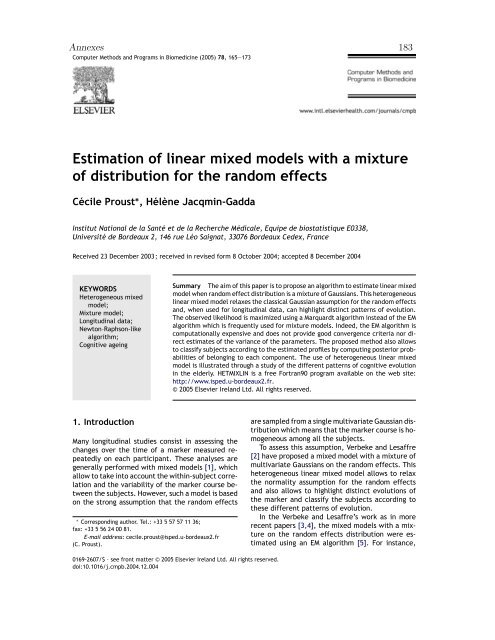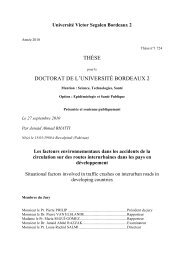Télécharger le texte intégral - ISPED-Enseignement à distance
Télécharger le texte intégral - ISPED-Enseignement à distance
Télécharger le texte intégral - ISPED-Enseignement à distance
- No tags were found...
Create successful ePaper yourself
Turn your PDF publications into a flip-book with our unique Google optimized e-Paper software.
Annexes 183Computer Methods and Programs in Biomedicine (2005) 78, 165—173Estimation of linear mixed models with a mixtureof distribution for the random effectsCéci<strong>le</strong> Proust ∗ ,Hélène Jacqmin-GaddaInstitut National de la Santé et de la Recherche Médica<strong>le</strong>, Equipe de biostatistique E0338,Université de Bordeaux 2, 146 rue Léo Saignat, 33076 Bordeaux Cedex, FranceReceived 23 December 2003; received in revised form 8 October 2004; accepted 8 December 2004KEYWORDSHeterogeneous mixedmodel;Mixture model;Longitudinal data;Newton–Raphson-likealgorithm;Cognitive ageingSummary The aim of this paper is to propose an algorithm to estimate linear mixedmodel when random effect distribution is a mixture of Gaussians. This heterogeneouslinear mixed model relaxes the classical Gaussian assumption for the random effectsand, when used for longitudinal data, can highlight distinct patterns of evolution.The observed likelihood is maximized using a Marquardt algorithm instead of the EMalgorithm which is frequently used for mixture models. Indeed, the EM algorithm iscomputationally expensive and does not provide good convergence criteria nor directestimates of the variance of the parameters. The proposed method also allowsto classify subjects according to the estimated profi<strong>le</strong>s by computing posterior probabilitiesof belonging to each component. The use of heterogeneous linear mixedmodel is illustrated through a study of the different patterns of cognitive evolutionin the elderly. HETMIXLIN is a free Fortran90 program availab<strong>le</strong> on the web site:http://www.isped.u-bordeaux2.fr.© 2005 Elsevier Ireland Ltd. All rights reserved.1. IntroductionMany longitudinal studies consist in assessing thechanges over the time of a marker measured repeatedlyon each participant. These analyses aregenerally performed with mixed models [1], whichallow to take into account the within-subject correlationand the variability of the marker course betweenthe subjects. However, such a model is basedon the strong assumption that the random effects∗ Corresponding author. Tel.: +33 5 57 57 11 36;fax: +33 5 56 24 00 81.E-mail address: ceci<strong>le</strong>.proust@isped.u-bordeaux2.fr(C. Proust).are samp<strong>le</strong>d from a sing<strong>le</strong> multivariate Gaussian distributionwhich means that the marker course is homogeneousamong all the subjects.To assess this assumption, Verbeke and Lesaffre[2] have proposed a mixed model with a mixture ofmultivariate Gaussians on the random effects. Thisheterogeneous linear mixed model allows to relaxthe normality assumption for the random effectsand also allows to highlight distinct evolutions ofthe marker and classify the subjects according tothese different patterns of evolution.In the Verbeke and Lesaffre’s work as in morerecent papers [3,4], the mixed models with a mixtureon the random effects distribution were estimatedusing an EM algorithm [5]. For instance,0169-2607/$ – see front matter © 2005 Elsevier Ireland Ltd. All rights reserved.doi:10.1016/j.cmpb.2004.12.004
















